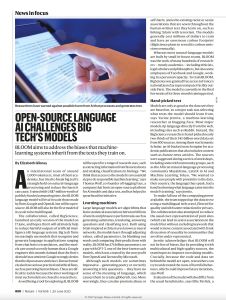Join getAbstract to access the summary!

Join getAbstract to access the summary!
Elizabeth Gibney
Open-Source Language AI Challenges Big Tech’s Models
BLOOM aims to address the biases that machine-learning systems inherit from the texts they train on.
Nature, 2022
What's inside?
The powerful BLOOM open-source natural language processing system rivals “big tech” models.
Recommendation
Currently in its final weeks of training, the BLOOM model for natural language processing is almost ready for full launch. With parameter sets rivaling those used by Google and OpenAI, the system’s originators seek to correct biases inherent in many systems that make them seem all too human – in the worst ways. Anyone who designs or uses AI should read this eye-opening report, and perhaps consider signing up for a test drive.
Summary
About the Author
Elizabeth Gibney is a senior physics reporter at Nature. She has written for Scientific American, the BBC and CERN.


















Comment on this summary